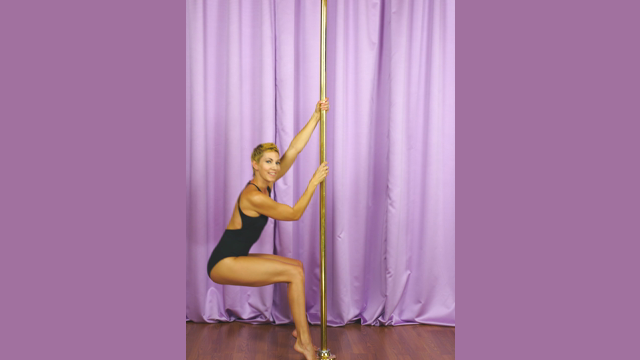FREE Split Grip (Easy up) Tutorial

Are you new to pole dance? If so, I want to make it clear that I do not expect you to achieve any of these grips right away. Some grips might feel more doable than others, but think of this tutorial as an introduction to Split Grips. The expectation is to work up to holding your body weight. I’ll be teaching you four different ways to do a split grip using a trick I call the EASY UP!
As a beginner pole dancer, to avoid forearm, and shoulder, issues limit your Split grip practice to 3 times per week, and no more than 10 attempts per side. I know it’s tempting to keep at it every day but trust me, your body will be much happier if you limit your attempts. Also a warm up is a very important aspect for injury prevention when working on Split Grips. So it’s not wise to work on this grip randomly during the day without warming up.
If you have questions or would like to see all of the information for each related tutorial such as, descriptions other exercises, stretches and suggested sets and reps. These are provided within each individual tutorial. Here is a list of links to take you directly to each related tutorial listed here.
Hand and wrist strength routine
Muscles Strengthened : ABDOMINALS / LATISSIMUS / TERES MAJOR / PECTORALS / POSTERIOR DELTOIDS / TRAPEZIUS / RHOMBOIDS / BICEPS / TRICEPS

Love the leg variation. I’ll have to try that!
For some reason the last one is easiest for me and the rest are harder.
That’s not unusual. If you have the shoulder strength the full split grip can be less effort. However, it’s also the one that can more easily cause injury when done wrong, over and over. The rest all use one biceps instead of the shoulder alone.
Would you say it’s a big misconception (or outdated knowledge) when pole teachers tell you your scapula should be back and down when the arm is overhead? They often use cues like “if your shoulders are coming towards your ears, that’s wrong” or “jam your scapula together like you’re trying to crush a pencil” (in the case of double overhead pulling). In full split grip, even Pole Ninja Dr. Kenneth Kao tells us to keep the shoulders level in his videos, but I definitely do find it much easier to lift myself when my pulling scapula is slightly raised.
It’s outdated when any fitness instructor says to pull the scapula back and down when reaching overhead. I started off with the idea of neutral is the best place to start, but found that people still felt like they had to pull the scapula back and down to “engage” the shoulder. So now I’m trying to make it more clear that no matter the arm position the scapula should follow. This is called Scapulohumeral rhythm and it’s the interplay between the scapula and the humerus during motion of the shoulder. Changing the scapulohumeral rhythm (like pulling the scapula down while lifting the arm up) affects the function of the glenohumeral joint and contributes shoulder impingement, rotator cuff pathology and shoulder instability.
Thank you for your detailed explanations, Veena! I’m wondering whether it’d be worth making a video explicitly addressing this difference in views, since a lot of us beginners might be supplementing your lessons with other online resources or in-person teachers who continue to give the older cues (even recently certified teachers). Or maybe I’m just a big nerd 😉
Here’s a video I made that’s towards the start of the beginner lessons https://www.studioveena.com/lessons/view/5e7034cf-2b58-4d29-a149-1be9ac110005 Not sure if this is helpful enough?
I watched your SOS video and regularly practice the scapula drills videos and find them very helpful 🙂 I just meant explicitly warning conflicted beginners that other resources might say otherwise but I can also see why you might not do so.
Could I use these exercises to train a half bracket grip? Those are pretty common at my studio, and I’d like to work up to one
Yes, half bracket is just another split grip variation 💜 Nice work understanding it’s the same muscle groups!